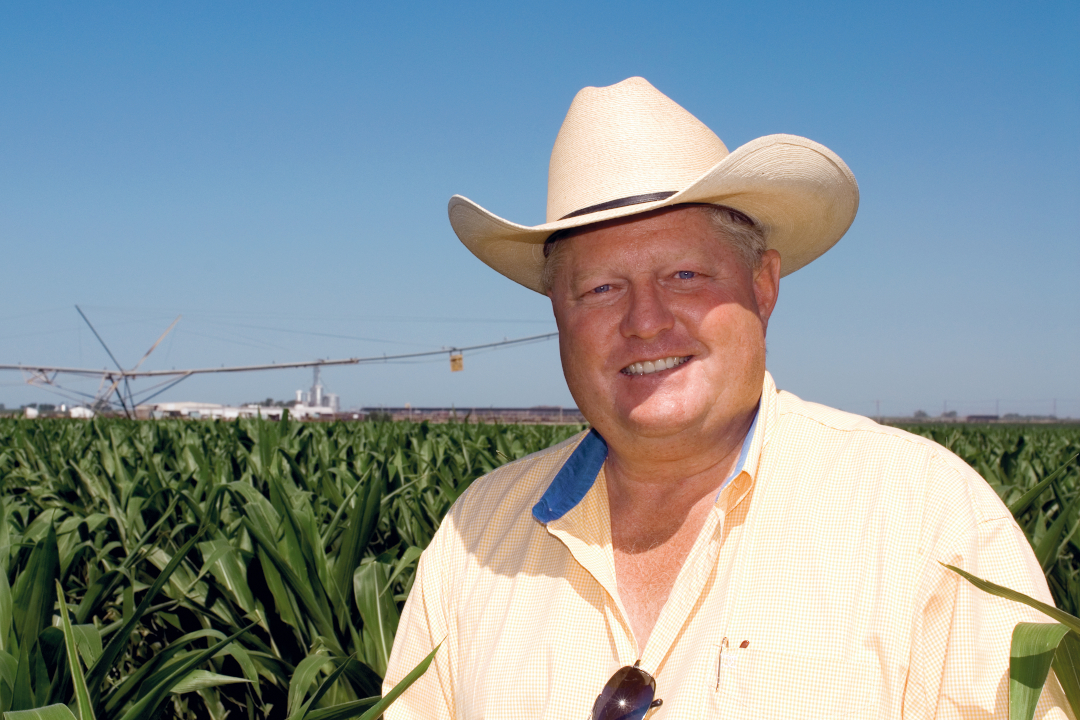Read stories from farmers all around the world and why they chose T-L.
Bob Gottsch
"I’ve never had to take a T-L off-line. All we do is just service them every winter."
If any one word could define Gottsch Cattle Co./Gottsch Enterprises of Hastings, Nebraska, it would have to be «diversified». Its farming and ranching operations are spread over the states of Nebraska, Kansas, Texas, and Louisiana, plus Argentina. Three feedlots feed out and finish a quarter million beef cattle annually.
Naturally, irrigation is a foundation of the entire business, and only center pivots are utilized-all T-L systems…43 in total. A half-dozen of these T-Ls have even been in service continually for 30 years. Why exclusively T-Ls?
According to Bob Gottsch, one of several reasons is, «I’ve never had to take a T-L off-line. All we do is just service them every winter.» He remembers when his father installed a couple of «challenging» electric center pivots on the home place near Omaha in 1975. Not too long after that the family got its first experience with T-L units that were already in place on another farm they bought near Hastings.
The inventory has grown to include six 1,500 foot long tow able T-L pivots in Argentina that each water three 200 acre circles every year, or 600 acres for each unit. The procedure is to start with corn, move to a circle of what’s called «first» soybeans planted a month later to get them up, back to finish the corn, then a third circle of «second» soybeans to start them, back to the first circle of soy-beans during flowering, and finally onto the second circle of soybeans during flowering. Rice is grown in Argentina.
However, for the second year, Gottsch is experimenting with simply irrigating with a T-L pivot rather than the worldwide traditional flooding of the crop. Although the cost of production is somewhat higher, yields are increased approximately 15 percent. And, use of a center pivot sprinkler means that he can produce rice on land that normally wouldn’t support the crop.
Meanwhile, the T-L pivots in Texas and Louisiana are used to irrigate Bermuda grass on which the family runs 350 to 400 pound stocker calves. In Louisiana, during the warm season, with supplement, they can graze at the rate of five head an acre. The cattle next move to wheat pasture or go on Flint Hills grass in Kansas.
From there, they head for one of the Kansas or Nebraska feedlots with adjacent fields irrigated by T-Ls. However, two things set a Gottsch Cattle Co. feedlot apart from most large feedlots: First, the waste water from their Nebraska feedlot-what Gottsch prefers to term «nutrient» water is distributed on the fields through the center pivots.
The only precaution required is to use special, self cleaning screens to prevent trash from plugging the nozzles. Solids are applied on 20,000 acres under agreements with other landowners. «What used to be a liability-the nutrients-is now an asset,» Gottsch explains. «It’s also one that’s become even more valuable as fertilizer costs have climbed.
We haven’t had to apply any commercial fertilizer on these fields for years.» Second, the 1,000 acres involved are now used to grow organic crops, and much of the acreage that used to grow corn for the feedlot, now produces food grade soybeans from which organic soy milk is made.
Other crops include organic popcorn and number two yellow corn for use by organic dairies. Noting that they will probably add alfalfa, wheat, and flax in the future, Gottsch points out, «There’s a variety of organic crops just starting to be in demand. We also have several swine facilities where, within the next two years, we’re going to be in organic crop production using ‘nutrient’ water.»
«It’s definitely a growing business,» he adds, pointing to an 18 to 22 percent annual growth rate. «Wal-Mart doubled its organic shelf space this year, and plans to double it again in another couple years. The generation of today seems to think that health is at the forefront. And, they have the money to buy the organics.»
Reflecting on how T-Ls last so long, he says that quite often the people he has working on the center pivots are not familiar with them. The T-Ls simplicity makes it easy for them to figure out. Gottsch remembers when he was 14 years old crawling up on his father’s first electric systems using a tester. And, while he recalls that he wasn’t scared of anything at that age, a unit’s electricity still made him a bit concerned.
Gottsch likens investing in T-L systems to buying a Mercedes, «A T-L is long-term value that saves you money as steel and other costs escalate,» he relates. «Two 30 year T-L systems over 60 years don’t cost as much as having to buy three 20 year systems of other brands, even considering the value of money over time. That’s why I’m going to keep buying T-Ls!»

- Products
- Center Pivot
- Crops
- Corn, Soybeans
- States
- Nebraska
- Countries
- United States

- Toll Free 1-800-330-4264
- Main Office 1-402-462-4128
- © 2025 T-L Irrigation
- Sitemap

